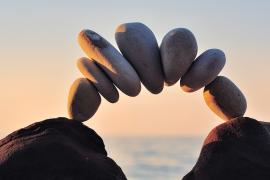Trade shows, camp fairs, and community expos bring vendors together in a virtual mega mall where like-minded people can efficiently research and compare products, services, solutions, and ideas. It's a place to find out what's new, what's hot, what's in, and what's out — all in one convenient location. More importantly, it's one of the few marketing channels left today in which vendors can engage in two-way, face-toface conversation with real customers and prospects.
As the 2009 American Camp Association (ACA) National Conference approaches, vendors throughout the country (and beyond) are preparing to share their camp-related goods and services with camp directors and owners eager to find new tools, strategies, and resources to better serve campers. At least that's the idea. This year, of course, the economy is on everyone's mind. Vendors may have to be a bit more creative in the way they attract visitors to their booths, price products, and follow up with new prospects.
Camps Show Off, Too!
While those vendors wanting to reach large numbers of camp professionals can take advantage of the annual ACA conference, your camp likely exhibits in camp fairs, community events, family expos, and other "trade shows" during the spring registration season. Whether you find these events to be "necessary evils" or an incredible opportunity to get face to face with prospective campers, you control the outcomes with good planning and effective follow-up.
Since biblical times, merchants, farmers, traders, and craftsmen have come together to display, barter, and trade goods with each other. Ancient caravans evolved into markets, fairs, and eventually, what we know today as trade shows and expositions. Although the technology and sophistication has changed dramatically, the result is the same — buyers and sellers coming together in a common facility or environment.
Trade shows range in size and format from large industrial booth mega-shows to small, table-top meetings and arts and craft fairs to huge consumer expositions. They allow attendees the ultimate in comparison shopping in a multi-sensory, people-oriented atmosphere.
Why Exhibit?
According to The Center for Exhibition Industry Research (formerly The Trade Show Bureau), 18 percent of all marketing dollars are allocated to trade shows and exhibits. There were close to 15,000 trade shows in the United States in 2004, making it a $100 billion industry. Every organization, from the entrepreneurs and the corporate giant to government agencies and nonprofits, can use the trade show as the "super sales call" to personally meet many important clients, citizens, suppliers, prospects, and industry leaders. In our hyper-busy culture of phone tag and e-mails, trade shows are one of the most powerful ways to establish and reinforce relationships.
Companies and organizations can utilize trade shows to meet many marketing objectives and goals such as:
- Prospecting for new customers
- Introducing new products and services
- Generating sales leads
- Generating actual sales at the show
- Enhancing your image and visibility
- Reaching a specific audience
- Establishing a presence in the marketplace
- Improving the effectiveness and efficiency of your marketing efforts
- Personally meeting your customers, competitors, and suppliers
- Gaining customer feedback about new products or marketing strategies
- Demonstrating your product in ways not possible using other marketing channels
- Recruiting staff, volunteers, distributors, or dealers
- Educating your target audience
Six Steps to Success
The trick to trade show success is to understand what your audience is looking for when he or she attends the show, create a message with your booth that addresses these needs, and follow up on all requests and leads. Ensure the success of your next trade show by following these six simple rules:
Evaluation
Carefully evaluate all prospective shows based on your target audience. Expositions such as ACA's National Conference have a reputation for attracting well-qualified park and recreation professionals. "Within the ACA exhibit hall," explains Kim Bruno, national sales manager for ACA, "vendors can reach more than twelve hundred influential decision makers representing approximately eight hundred camps without wasting time, energy, and resources to those uninterested in recreation- oriented products and services." She continues, "Many ACA members rely on the exhibit hall to compare products, meet face-to-face with suppliers, and gather valuable information to improve their camp's technology, operations, and services."
When choosing to participate in trade show opportunities ask the following questions:
- Who is the targeted audience?
- How many attendees are expected?
- Will decision-makers be there?
- Will your competitors be exhibiting?
- What are the total costs involved including travel, food, and lodging?
- How many total booths will be sold?
Your goal is to find the show that will give you the most return for your marketing investment.
Define and Clarify Your Objectives
What are the outcomes you would like to see as a result of exhibiting in this show? Do you want to build a mailing list? Generate qualified leads? Discover new prospects? Develop a strong company image? Create greater awareness among a new vertical market? Strengthen relationships with existing customers? Explore the competition in a non-threatening environment? As with all marketing, your objectives should be clear and measurable. It is also important to make sure that everyone involved with the show understands and is committed to reaching the established goals.
Carefully Design Your Trade Show Booth, Display, or Table Top
Remember that your display is a direct reflection on your company. Ask yourself: "Is this the image we want to project to our customers, prospects, suppliers, and competitors." It is important to create a space that is conducive to conducting business. When planning the theme and graphics of your display, use simple messages and graphics that visually explain your product's benefits.
Booths can be very simple, highly technical, or have actual bells and whistles. No matter the complexity, plan and budget well in advance. You do not want to leave attendees with the impression that your exhibit was thrown together at the last minute.
Prior to the show, it is also important to ask about electrical outlets, phone service, plants, furniture, shipping, handling, and other additional costs. These factors are often overlooked and can cause unnecessary complications.
Create a Three-Phase Promotional Plan — Pre-Show, At-Show, and Post-Show
Before the event, request a list of preregistered attendees. Mail to your key prospects a special invitation, incentive, or offer to ensure that they visit your booth. For example, a postcard could read: "Bring this by our booth to receive a free conference tote bag (or T-shirt, golf balls, travel mug, umbrella, work gloves, pedometer . . . you get the idea). Remember to match your premium to the interests of your target prospect.
During the show, make sure that you have plenty of brochures, price lists, and catalogs to distribute freely to attendees. The last thing you want to worry about is running out of your collateral material. It is better to have too much than not enough!
What can you do to increase traffic to your booth? Some ideas include promotional product giveaways; drawings; games, such as spinning wheels or putting contests; interactive videos; caricature artists; celebrity appearances; or product or service demonstrations. Other unique booth attractions might be foot or chair massage, temporary tattoos, or free food. Be careful, however, not to attract the "wrong" crowd. The aim is to create a message that appeals to your best prospect's business or personal interests.
It is also imperative that a simple system is devised to capture and organize information about the attendees. Are business cards adequate or do you want to gather more explicit data concerning each contact's interests or product usage? Create forms ahead of time so that your staff can easily collect predetermined data. Consider using a laptop computer to instantly build a data base and input contacts.
The most forgotten promotional opportunity involves post-show follow-up. To simplify this often overwhelming task, prepare packets, letters, or thank-you cards before the show. Send all requested information and materials within one week of the event to prove your efficiency to your new contacts. Your quick rate of responsiveness can turn your show prospects into impressed customers while your competitors are still digging through their notes and unpacking their boxes.
Hand Select and Train Your Booth Personnel
No matter how creative your promotions or unique your booth, nothing can make up for uninformed, exhausted, or nonexistent personnel. A trade show is not the time to train a new employee. Booth personnel need to be knowledgeable about your company, including its products and services. They should be enthusiastic, energetic, and be able to handle multiple conversations at once.
Statistics show that personnel will talk with as many people in one trade show day as they usually would in a month. Although staff should stand while working the booth, they should also take plenty of breaks to compensate for the emotional and physical toll.
Treat every person who walks into your booth like they are worth a million bucks. When busy with others, acknowledge new visitors with eye contact and a smile. Sound like common sense? Next time you are at a trade show (or retail shop) notice how you are greeted and treated. Were you made to feel welcome or was the staff person chatting on the phone or talking with a co-worker? Customer service is just as important to exhibitors as it is to restaurants, hotels, hospitals, retail merchants, and service businesses.
Evaluate and Review Your Trade Show Results
Keep in mind that conventions, meetings, and trade shows can be a lot of fun. But they are also part of your marketing mix. By reviewing the show's attendance, your booth, promotional materials, customer service, and follow-up based on your objectives, you are sure to make it big in the world of "show business"!
Jodi Rudick, M.A.S., president, ADvisors Marketing Group, is a speaker, trainer, and consultant specializing in marketing, sales, and communication camps. Rudick can help with your trade show promotions and can be reached at 760-809-3231 or jodi@advisorsmarketing.com. Learn more at www.advisorsmarketing.com.
Originally published in the 2009 January/February issue of Camping Magazine.




